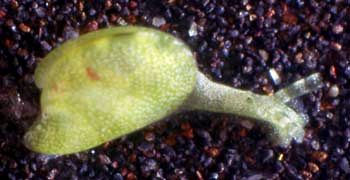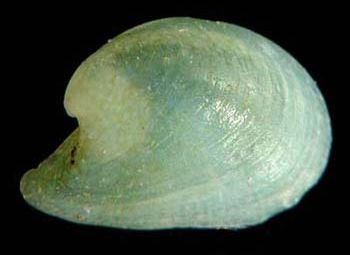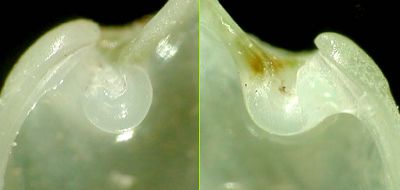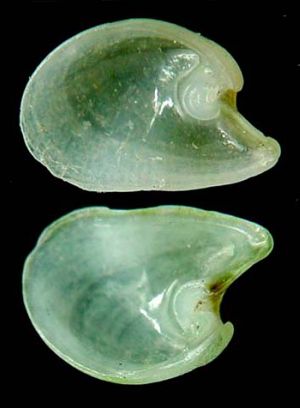

Julia sp. 2
Order: SACOGLOSSA
Superfamily: OXYNOOIDEA
Family: Juliidae
DISTRIBUTION
Hawaii, Midway Atoll and Raratonga (Cook Ids).
PHOTO
Live animal 4.2 mm long, from algae wash, Alelele Stream, Maui, Hawaiian Ids, May 7, 1996. Depth 4.6 - 13.7 m. Shell 2.7 mm long, from beach drift at Maalaea Bay, Maui, 1982. Photos: Cory Pittman
Julia sp. 2 is the least commonly seen of the the Hawaiian species of Julia. It has a maximum shell length of 3.7 mm. I know of only a few live animals. All were in rocky habitats at over 4.5 m suggesting that it may be restricted to somewhat deeper water than the other Hawaiian Julia spp. The color is consistent with the light green shell covered by a fine, darker green reticulation. There is no brown pigment with the exception of a small amount of "stain" ventral to the hinge in some specimens. In live animals, the body is densely covered with cream flecks and cream flecks form basal, medial and terminal bands on the rhinophores. The hinge is very large and the central, tooth-like knob has a prominent, "C-shaped" apical depression.
[See separate messages for details of Hawaiian records and the shell]
Authorship detailsPittman, C., 2001 (October 12) Julia sp. 2 [In] Sea Slug Forum. Australian Museum, Sydney. Available from http://www.seaslugforum.net/find/julisp2
Related messages
Hawaiian Julia sp. 2
October 12, 2001
From: Cory Pittman


Julia sp. 2 is the least commonly seen of the Hawaiian species. I've found a couple dozen valves in sand samples from beach drift and shallow water (I believe I have substantially more in my backlog of unsorted samples from deeper water). Based on that limited number, it has a maximum shell length of 3.7 mm. I've only found one live animal in an algae wash but Pauline Fiene-Severns found two others (our first live specimens). All were in rocky habitats at over 4.5 m suggesting that it may be restricted to somewhat deeper water than the other Hawaiian Julia spp. Both shells and live animals were from moderately exposed to exposed areas. The color is consistent with the light green shell covered by a fine, darker green reticulation. There is no brown pigment with the exception of a small amount of "stain" ventral to the hinge in some specimens. In live animals, the body is densely covered with cream flecks and cream flecks form basal, medial and terminal bands on the rhinophores. The hinge is very large and the central, tooth-like knob has a prominent, "C-shaped" apical depression. [See separate message for detailed images of the shell].
I've found one valve each in sand samples (sent to me by Pauline Fiene-Severns and Jerry Flora) from Midway Atoll and Raratonga.
The live shot is of a 4.2 mm animal collected in an algae wash at Alelele Stream, Maui on May 7, 1996. The wash covered a depth range of 4.6 m to 13.7 m. The shell photos are of a closely matched (though moderately worn) pair 2.7 mm in length. They were in sand samples collected from beach drift at Maalaea Bay, Maui in 1982 and Makuleia Bay, Maui in 1987.
Cory Pittman
cory@cet.com
Pittman, C., 2001 (Oct 12) Hawaiian Julia sp. 2. [Message in] Sea Slug Forum. Australian Museum, Sydney. Available from http://www.seaslugforum.net/find/5378Shell of Julia sp. 2
October 12, 2001
From: Cory Pittman

Here are detailed shell photos of Julia sp. 2 from Hawaii to accompany my earlier message.
Julia sp. 2 is the least commonly seen of the Hawaiian species. I've found a couple dozen valves in sand samples from beach drift and shallow water. Based on that limited number, it has a maximum shell length of 3.7 mm. The color is consistent with the light green shell covered by a fine, darker green reticulation. There is no brown pigment with the exception of a small amount of "stain" ventral to the hinge in some specimens. The hinge is very large and the central, tooth-like knob has a prominent, "C-shaped" apical depression.
The shell photos are of a closely matched (though moderately worn) pair 2.7 mm in length. They were in sand samples collected from beach drift at Maalaea Bay, Maui in 1982 and Makuleia Bay, Maui in 1987.
Cory Pittman
cory@cet.com


